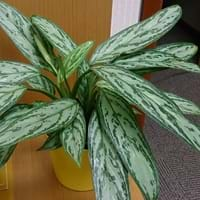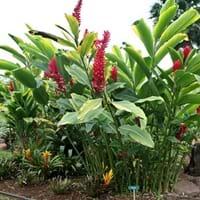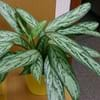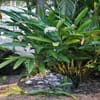Life Span
Perennial
Perennial
Type
Tender Perennial
Tender Perennial
Origin
Southern Asia
Melanesia, Micronesia, Polynesia
Types
Not Available
not available
Number of Varieties
Not Available
Habitat
subtropical regions, Tropical areas
Humid climates
USDA Hardiness Zone
14-15
9-15
Sunset Zone
H2
H1, H2, 14, 15, 16, 17, 18, 19, 20, 21, 22, 23, 24
Habit
Clump-Forming
Upright/Erect
Minimum Height
Not Available
Minimum Width
Not Available
Flower Color
White, Light Green, Ivory
White, Red, Pink
Flower Color Modifier
Not Available
Not Available
Fruit Color
Red, Orange
Not Available
Leaf Color in Spring
Not Available
Green, Dark Green
Leaf Color in Summer
Not Available
Dark Green
Leaf Color in Fall
Not Available
Dark Green
Leaf Color in Winter
Not Available
Dark Green
Leaf Shape
Lanceolate
Oblong
Plant Season
Spring, Summer, Fall, Winter
Spring, Summer, Fall, Winter
Sunlight
Partial Sun, Partial shade, Full Shade
Partial Sun, Partial shade
Growth Rate
Not Available
Fast
Type of Soil
Loam, Sand
Loam, Sand
The pH of Soil
Acidic, Neutral, Alkaline
Acidic, Neutral
Soil Drainage
Average
Average
Bloom Time
Indeterminate
Indeterminate
Tolerances
Drought
Drought
Where to Plant?
Ground, Pot
Container, Ground, Pot
How to Plant?
Cuttings, Divison
From Rhizomes, Seedlings
Plant Maintenance
Medium
Low
Watering Requirements
Allow to dry out slightly between watering
Keep the ground moist but not water-logged
In Summer
Lots of watering
Lots of watering
In Spring
Moderate
Moderate
In Winter
Average Water
Average Water
Soil pH
Acidic, Neutral, Alkaline
Acidic, Neutral
Soil Type
Loam, Sand
Loam, Sand
Soil Drainage Capacity
Average
Average
Sun Exposure
Partial Sun, Partial shade, Full Shade
Partial Sun, Partial shade
Pruning
Remove damaged leaves, Remove dead branches, Remove dead leaves
Remove damaged leaves, Remove dead branches, Remove dead leaves
Fertilizers
All-Purpose Liquid Fertilizer
All-Purpose Liquid Fertilizer, Fertilizer every month during spring, Requires high amount of nitrogen, since leafy plants, use higher nitrogen content fertilizer
Pests and Diseases
Aphids, Mealybugs, Nematodes, Spider mites
Aphids, Earwigs, fungus, Mealybugs, Nematodes, Red blotch, Root rot, Scale, Thripes
Plant Tolerance
Drought
Drought
Flowers
Insignificant
Showy
Flower Petal Number
Not Available
Single
Fragrant Bark/Stem
No
Yes
Foliage Texture
Not Available
Bold
Foliage Sheen
Glossy
Matte
Attracts
Not Available
Not Available
Allergy
inflammation in lips, Skin irritation, Throat itching
Not Available
Aesthetic Uses
Showy Purposes
Landscape Designing, Showy Purposes
Beauty Benefits
Not Available
Not Available
Environmental Uses
Air purification
Air purification
Medicinal Uses
Not Available
Antirheumatic, Appetite enhancer, Asthma, Bronchitis, Cold, Headache, Laxative, Muscle Pain, Sore throat, Sweat bullets, Tonsillitis
Part of Plant Used
Whole plant
Flowers, Root bark
Other Uses
Not Available
Culinary use, Used as Ornamental plant
Used As Indoor Plant
Yes
No
Used As Outdoor Plant
Yes
Yes
Garden Design
Bedding Plant, Container, Edging, Groundcover, Houseplant, Tropical
Container, Cutflower, Feature Plant, Foundation, Mixed Border, Tropical
Botanical Name
AGLAONEMA 'Emerald Bay'
ALPINIA purpurata
Common Name
Aglaonema, Chinese Evergreen
Jungle Queen, Red Ginger
In Hindi
Chinese Evergreen
लाल अदरक
In German
Kolbenfaden
Red Ginger
In French
Chinese Evergreen
Red Ginger
In Spanish
Chinese Evergreen
Red Ginger
In Greek
Chinese Evergreen
Red Ginger
In Portuguese
Chinese Evergreen
Red Ginger
In Polish
Chinese Evergreen
Red Ginger
In Latin
Chinese Evergreen
Gingiberi Rubrum
Phylum
Tracheophyta
Magnoliophyta
Class
Liliopsida
Liliopsida
Order
Alismatales
Zingiberales
Family
Araceae
Zingiberaceae
Clade
Not Available
Angiosperms, Commelinids, Monocots
Tribe
Aglaonemateae
Alpinieae
Subfamily
Not Available
Alpinioideae
Number of Species
Not Available
Not Available
Season and Care of Chinese Evergreen and Red Ginger Plant
Season and care of Chinese Evergreen and Red Ginger Plant is important to know. While considering everything about Chinese Evergreen and Red Ginger Plant Care, growing season is an essential factor. Chinese Evergreen season is Spring, Summer, Fall and Winter and Red Ginger Plant season is Spring, Summer, Fall and Winter. The type of soil for Chinese Evergreen is Loam, Sand and for Red Ginger Plant is Loam, Sand while the PH of soil for Chinese Evergreen is Acidic, Neutral, Alkaline and for Red Ginger Plant is Acidic, Neutral.
Chinese Evergreen and Red Ginger Plant Physical Information
Chinese Evergreen and Red Ginger Plant physical information is very important for comparison. Chinese Evergreen height is Not Available and width Not Available whereas Red Ginger Plant height is 180.00 cm and width 30.00 cm. The color specification of Chinese Evergreen and Red Ginger Plant are as follows:
Chinese Evergreen flower color: White, Light Green and Ivory
Chinese Evergreen leaf color: Not Available
Red Ginger Plant flower color: White, Red and Pink
- Red Ginger Plant leaf color: Green and Dark Green
Care of Chinese Evergreen and Red Ginger Plant
Care of Chinese Evergreen and Red Ginger Plant include pruning, fertilizers, watering etc. Chinese Evergreen pruning is done Remove damaged leaves, Remove dead branches and Remove dead leaves and Red Ginger Plant pruning is done Remove damaged leaves, Remove dead branches and Remove dead leaves. In summer Chinese Evergreen needs Lots of watering and in winter, it needs Average Water. Whereas, in summer Red Ginger Plant needs Lots of watering and in winter, it needs Average Water.





